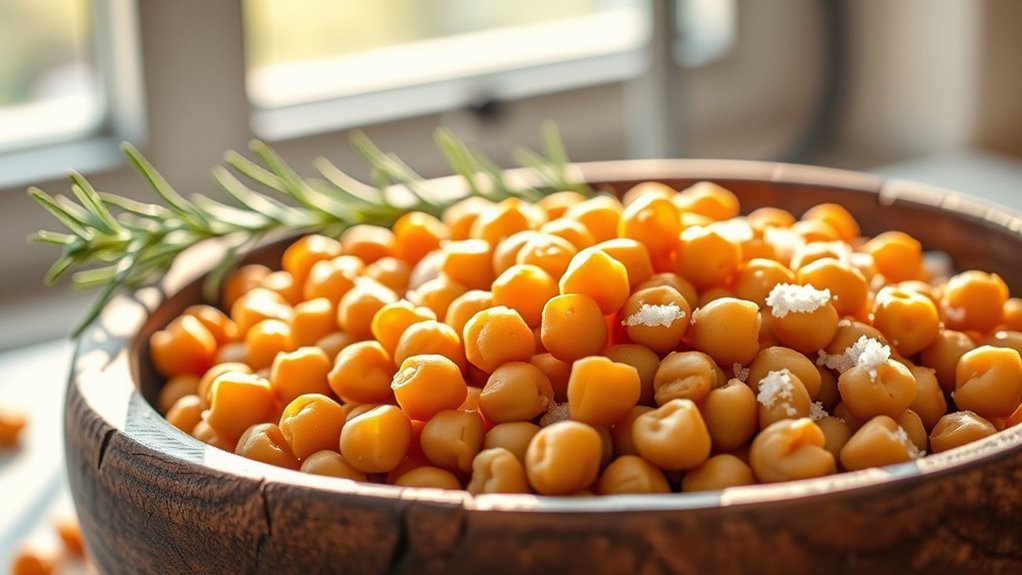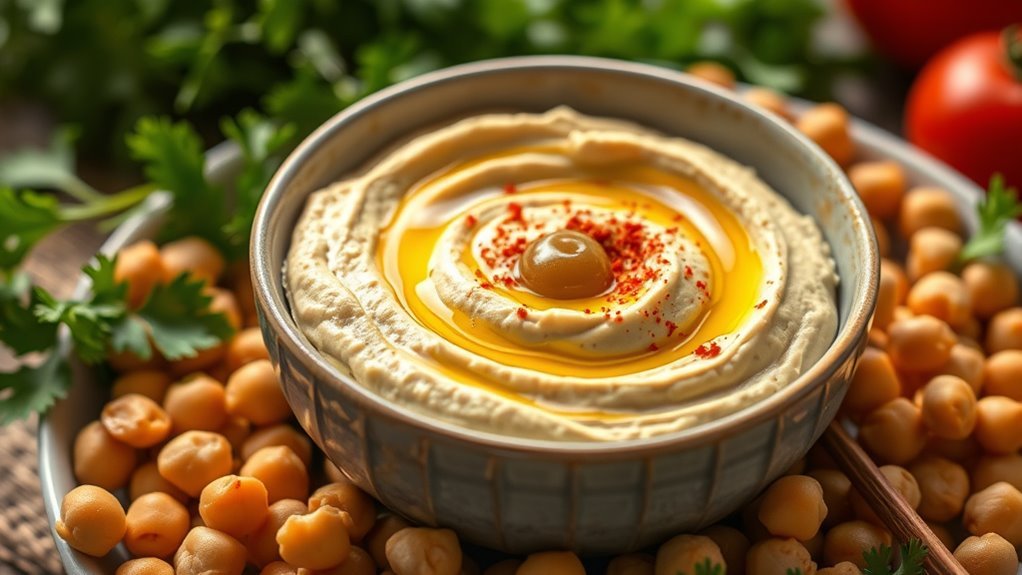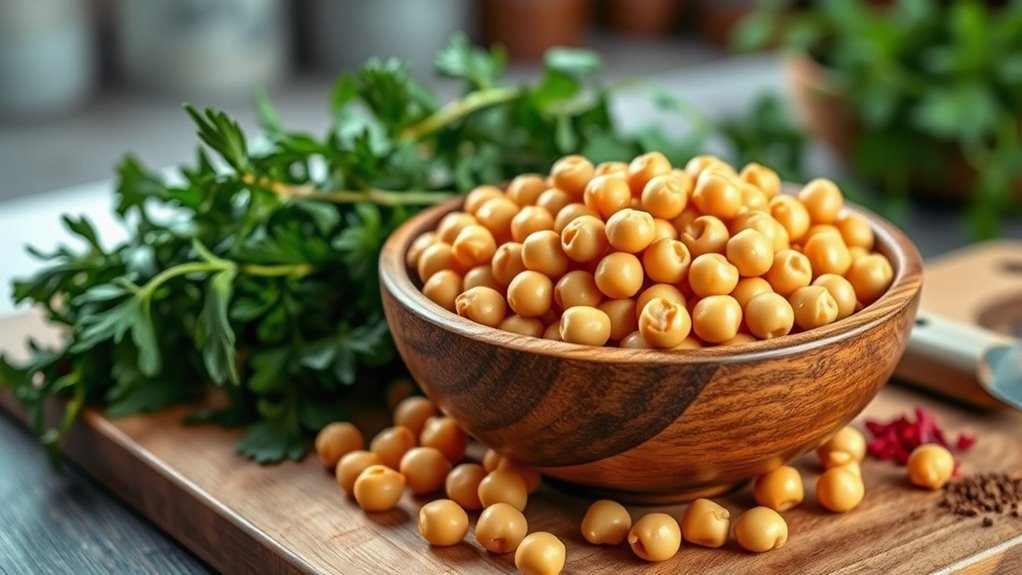Chickpeas aren’t ideal for a strict keto diet, as they contain about 27 grams of carbs per cooked cup. While they’re packed with protein, fiber, and essential nutrients, their higher carb content can challenge your macro goals. However, if you enjoy their benefits, you can incorporate them in moderation alongside low-carb ingredients. Balancing their use helps you stay on track. Exploring alternatives and strategies can further enhance your keto journey, offering you tasty and satisfying options.
Nutritional Profile of Chickpeas

Chickpeas, often celebrated for their versatility, boast a unique nutritional profile that makes them a popular choice in various diets. One of the primary chickpea benefits is their impressive protein content, offering about 15 grams per cooked cup. This makes them an excellent plant-based protein source, particularly for those seeking alternatives to animal products. Additionally, chickpeas are rich in fiber, which aids digestion and promotes satiety, helping you feel fuller longer. They also provide essential vitamins and minerals, including folate, iron, and magnesium, contributing to overall health. Incorporating chickpeas into your meals not only diversifies your protein sources but also supports a balanced diet, aligning with your desire for freedom in food choices while nourishing your body.
Carb Content Analysis

When considering chickpeas as part of your diet, it’s important to examine their carbohydrate content, especially if you’re following a low-carb or ketogenic lifestyle. Chickpeas contain about 27 grams of carbs per cup, which can be significant for those monitoring their intake. Various chickpea varieties may offer slightly different carb counts, but they generally remain high in carbohydrates. If you’re looking for carb substitutions, you might explore options like cauliflower or zucchini, which provide lower carb alternatives while still allowing you to enjoy satisfying meals. While chickpeas are nutritious, their carb content could pose challenges for strict keto dieters. Balancing your intake and finding suitable alternatives can help maintain your desired dietary freedom while enjoying diverse flavors.
Comparison With Other Legumes

When comparing chickpeas to other legumes, you’ll notice significant differences in their carb content and overall nutritional profiles. For instance, while lentils and black beans offer a similar protein boost, they may have lower carbohydrate levels than chickpeas. Understanding these variations can help you make informed choices that align with your dietary goals.
Carb Content Analysis
While many legumes are often considered healthy additions to diets, their carb content varies considerably, making some more suitable for a ketogenic lifestyle than others. Chickpea varieties, for example, tend to be higher in carbs than many other legumes. Here’s a quick comparison to help you evaluate your carb alternatives:
| Legume | Net Carbs (per 100g) |
|---|---|
| Chickpeas | 27g |
| Lentils | 20g |
| Black Beans | 16g |
When you’re steering through a keto diet, it’s crucial to keep an eye on these figures. While chickpeas offer nutritional benefits, their higher carb content might not align well with your goals. Consider other legumes if you need to lower your carb intake.
Nutritional Profile Comparison
Although chickpeas are a popular choice due to their versatility and health benefits, it’s essential to compare their nutritional profile with other legumes to make informed dietary decisions. While chickpea varieties like Garbanzo beans offer a decent protein source, they contain about 27 grams of carbs per cup, making them less ideal for strict keto adaptations. In contrast, lentils provide more fiber but still carry a higher carb count. Black beans and kidney beans also present similar challenges for keto dieters. If you’re looking for lower-carb options, consider edamame or green beans. Understanding these differences helps you navigate your dietary choices while enjoying the freedom to indulge in various legumes.
Benefits of Chickpeas on a Keto Diet
Chickpeas offer a nutrient-dense profile that can complement your keto diet, providing essential vitamins and minerals. Their high fiber content not only aids digestion but also helps keep you feeling full, which can be beneficial for weight management. Plus, their versatility in recipes allows you to incorporate them in various dishes while maintaining your dietary goals.
Nutrient Density Profile
If you’re considering incorporating chickpeas into your keto diet, it’s important to examine their nutrient density profile. Chickpeas offer a variety of essential nutrients that can enhance nutrient absorption and provide significant health benefits.
| Nutrient | Amount per 100g |
|---|---|
| Protein | 9g |
| Iron | 2.9mg |
| Magnesium | 48mg |
These nutrients contribute not only to muscle and bone health but also support energy levels. While chickpeas are higher in carbs than typical keto foods, their protein and mineral content can help balance your overall nutrient intake. By understanding their nutrient density, you can make informed choices that fit your lifestyle and dietary goals.
Fiber Content Benefits
Fiber plays an essential role in digestive health, and incorporating chickpeas into your keto diet can provide significant benefits. Chickpeas are high in fiber, which helps maintain regular bowel movements and supports a healthy gut. This fiber content also contributes to satiety benefits, helping you feel full longer and reducing the temptation to snack on higher-carb foods. When you’re on a keto diet, managing hunger is vital, and chickpeas can help you achieve that balance without compromising your carb limits too severely. While they do contain some carbs, their fiber offsets this impact, making them a more favorable option. Embracing chickpeas can enhance your dietary freedom while supporting your overall wellness goals.
Versatile Recipe Options
When it comes to incorporating chickpeas into your keto diet, the versatility of this legume opens up a world of delicious recipe options. You can whip up invigorating chickpea salads by mixing them with leafy greens, avocado, and a zesty dressing. This adds fiber and protein, keeping you satisfied. For a quick treat, consider chickpea snacks like roasted chickpeas seasoned with your favorite spices—crunchy, flavorful, and a great alternative to traditional chips. While chickpeas aren’t ultra-low in carbs, they can still fit into a well-planned keto meal if portioned correctly. Balancing their nutritional value with other low-carb ingredients allows you to enjoy their benefits without straying too far from your keto goals. Enjoy the freedom to experiment!
How to Incorporate Chickpeas Into Your Meals
Although chickpeas are often associated with higher-carb diets, they can still find a place in your meals without compromising your nutritional goals. For effective meal prep, consider incorporating chickpeas in moderation as a protein source. You can roast them for a crunchy snack or blend them into a creamy hummus to pair with fresh veggies. When it comes to flavor pairing, chickpeas work well with spices like cumin and paprika, adding depth to salads or grain bowls. Try tossing them with greens, avocado, and a zesty dressing for a satisfying dish. By balancing portion sizes and combining them with low-carb ingredients, you can enjoy chickpeas while maintaining a flexible and fulfilling diet.
Alternative Low-Carb Options
If you’re looking for alternative low-carb options to replace chickpeas in your meals, there are several nutritious choices that can fit seamlessly into your diet. Consider cauliflower, which can be mashed or riced to mimic the texture of chickpeas while keeping carbs low. Another great low carb alternative is zucchini; you can spiralize it for salads or sauté it in stir-fries. Edamame is also a healthy substitute, offering protein and fiber without the high carb count. If you’re after something crunchy, try roasted pumpkin seeds or nuts like almonds. These options not only maintain your keto goals but also provide essential nutrients. Embrace these healthy substitutes for a satisfying and flavorful culinary experience.
Personalizing Your Keto Plan
To truly make the keto diet work for you, personalizing your plan is essential. This means considering your individual preferences and adjusting your customized macros to fit your lifestyle. Here are four key steps to help you create a tailored approach:
Personalizing your keto plan is vital for success—tailor your macros to fit your unique lifestyle and preferences.
- Identify Your Goals: Determine whether you want to lose weight, gain muscle, or improve health markers.
- Assess Your Activity Level: Your physical activity will influence your macro needs—more active individuals may require different ratios.
- Experiment with Food Choices: Try various foods to see which ones satisfy you while keeping you within your carb limits.
- Monitor Your Progress: Keep track of how your body responds and be ready to adjust your macros as needed.
This personalized approach makes the keto diet more sustainable and enjoyable for you.
Final Thoughts on Chickpeas and Keto
When considering whether chickpeas fit into a keto diet, it’s important to weigh their nutritional profile against your personal macro goals. While chickpeas are nutritious, they’re also higher in carbs than many keto-friendly options. If you’re meal prepping for a low-carb lifestyle, it might be worth exploring chickpea alternatives like zucchini noodles or cauliflower rice.
Here’s a quick comparison of chickpeas and some alternatives:
| Food Item | Carbs (per 100g) | Protein (per 100g) |
|---|---|---|
| Chickpeas | 27g | 9g |
| Zucchini Noodles | 3g | 1g |
| Cauliflower Rice | 5g | 2g |
| Spinach | 1g | 3g |
| Broccoli | 7g | 3g |
Ultimately, choose what aligns with your keto journey!


